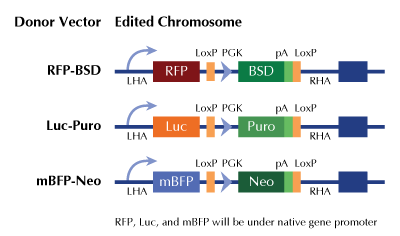PTEN Human Gene Knockout Kit (CRISPR)
CAT#: KN202627RB
PTEN - human gene knockout kit via CRISPR, HDR mediated
Functional Cassette: GFP-puro Luciferase-Puro mBFP-Neo
HDR-mediated knockout kit validation
USD 1,657.00
2 Weeks*
Specifications
| Product Data | |
| Format | 2 gRNA vectors, 1 RFP-BSD donor, 1 scramble control |
| Donor DNA | RFP-BSD |
| Symbol | PTEN |
| Locus ID | 5728 |
| Components |
KN202627G1, PTEN gRNA vector 1 in pCas-Guide CRISPR vector KN202627G2, PTEN gRNA vector 2 in pCas-Guide CRISPR vector KN202627RBD, donor DNA containing left and right homologous arms and RFP-BSD functional cassette. GE100003, scramble sequence in pCas-Guide vector |
| Disclaimer | These products are manufactured and supplied by OriGene under license from ERS. The kit is designed based on the best knowledge of CRISPR technology. The system has been functionally validated for knocking-in the cassette downstream the native promoter. The efficiency of the knock-out varies due to the nature of the biology and the complexity of the experimental process. |
| Reference Data | |
| RefSeq | NM_000314, NM_001304717, NM_001304718 |
| UniProt ID | P60484 |
| Synonyms | 10q23del; BZS; CWS1; DEC; GLM2; MHAM; MMAC1; PTEN1; TEP1 |
| Summary | This gene was identified as a tumor suppressor that is mutated in a large number of cancers at high frequency. The protein encoded by this gene is a phosphatidylinositol-3,4,5-trisphosphate 3-phosphatase. It contains a tensin like domain as well as a catalytic domain similar to that of the dual specificity protein tyrosine phosphatases. Unlike most of the protein tyrosine phosphatases, this protein preferentially dephosphorylates phosphoinositide substrates. It negatively regulates intracellular levels of phosphatidylinositol-3,4,5-trisphosphate in cells and functions as a tumor suppressor by negatively regulating AKT/PKB signaling pathway. The use of a non-canonical (CUG) upstream initiation site produces a longer isoform that initiates translation with a leucine, and is thought to be preferentially associated with the mitochondrial inner membrane. This longer isoform may help regulate energy metabolism in the mitochondria. A pseudogene of this gene is found on chromosome 9. Alternative splicing and the use of multiple translation start codons results in multiple transcript variants encoding different isoforms. [provided by RefSeq, Feb 2015] |
Documents
| Product Manuals |
| FAQs |
| SDS |
Resources
Other Versions
| SKU | Description | Size | Price |
|---|---|---|---|
| KN202627 | PTEN - human gene knockout kit via CRISPR, HDR mediated |
USD 1,657.00 |
|
| KN202627BN | PTEN - human gene knockout kit via CRISPR, HDR mediated |
USD 1,657.00 |
|
| KN202627LP | PTEN - human gene knockout kit via CRISPR, HDR mediated |
USD 1,657.00 |
|
| KN402627 | PTEN - KN2.0, Human gene knockout kit via CRISPR, non-homology mediated. |
USD 1,657.00 |
|
| GA103894 | PTEN CRISPRa kit - CRISPR gene activation of human phosphatase and tensin homolog |
USD 1,657.00 |
{0} Product Review(s)
Be the first one to submit a review






























































































































































































































































 Germany
Germany
 Japan
Japan
 United Kingdom
United Kingdom
 China
China
